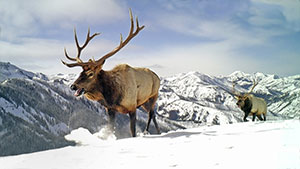Another fearsome disease has found its way into the heart of one of Wyoming’s protected places and greatest controversies.
Wyoming Game and Fish has confirmed that an elk in Grand Teton National Park has tested positive for Chronic Wasting Disease on Dec. 16. The department’s Wildlife Health Laboratory ran samples from a cow elk harvested thru Grand Teton’s herd reduction program.
Its mandatory for elk harvested in the park to be tested for CWD as Game and Fish continues to monitor the debilitating disease and its spread throughout Wyoming. Intensive CWD surveillance of the Jackson elk herd has been ongoing since 2009, with over 4,500 CWD samples collected and tested for the entire Jackson elk herd with more than 1,400 samples collected through the park’s elk reduction program alone.
This case is significant for several reasons. This is not only Grand Teton’s first confirmed case of CWD in elk, but it’s also the first in all of northwest Wyoming. Furthermore, it’s the first case discovered this close to the National Elk Refuge – and its feedgrounds – in Jackson.
Established in 1912 as a protected sanctuary for the elk herds of the Greater Yellowstone Ecosystem, the National Elk Refuge’s practices have been a source of controversy for several years now. Biologists continue to clash with the public over their suggestion to stop the winter feeding of elk herds.
During the harshest months of winter, the refuge distributes hay to the thousands of elk that congregate at the Refuge for that specific reason. Biologists have been pushing to stop the feedings and drive the elk back to forging for a natural winter diet.
Their reason is simple and a little close to home: chronic wasting disease. When thousands of elk unnaturally congregate, it increases the chance of transmission amongst those elk, who will then transmit it further along the herd’s extensive migration routes.
In a sense, biologists are trying to shut down an elk restaurant so they will avoid going out to eat and practice social distancing to prevent disease.
Now that an elk in Grant Teton has tested positive for CWD, it adds urgency to the plans to counter the disease before it spreads further. Public feedgrounds will remain open, however, and there’s no indication that the Grant Teton discovery will change that for the discernible future.
CWD is a contagious neurological disease that can spread to many of Wyoming’s native deer. It causes degeneration of the brains of infected animals resulting in emaciation, abnormal behavior, loss of bodily functions. It almost always results in death.
To date, there have been no cases of CWD in humans and no strong evidence for the occurrence of CWD in people. However, experimental studies raise the concern that CWD may pose a risk to humans, making it important to continue studying and monitoring the disease while preventing its spread.
CWD is not a new phenomenon in northwest Wyoming. The first sign of the disease in Grand Teton National Park was found in a mule deer in November 2018. A bull elk harvested in Meeteetse tested positive in August 2018.
No traces have been discovered in mule deer or elk in Yellowstone National Park.










